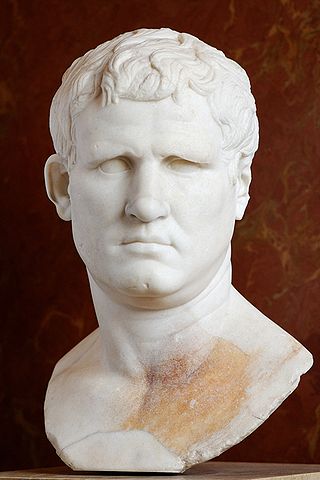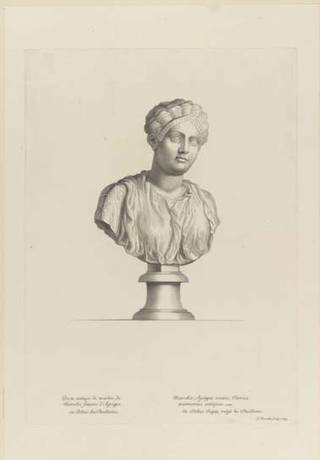Related Research Articles

Marcus Vipsanius Agrippa was a Roman general, statesman and architect who was a close friend, son-in-law and lieutenant to the Roman emperor Augustus. Agrippa is well known for his important military victories, notably the Battle of Actium in 31 BC against the forces of Mark Antony and Cleopatra. He was also responsible for the construction of some of the most notable buildings of his era, including the original Pantheon.

Antonia the Elder was a niece of the first Roman emperor, Augustus, being the eldest daughter of Octavia the Younger and her second husband, the Triumvir Mark Antony. She married Lucius Domitius Ahenobarbus and became the paternal grandmother of the emperor Nero.
Decimus Junius Silanus Torquatus was a Roman senator who lived during the 1st century.
Paullus Aemilius Lepidus was a Roman senator.

Vipsania Agrippina was the first wife of the Emperor Tiberius. She was the daughter of Marcus Vipsanius Agrippa and Attica, thus being a granddaughter of Titus Pomponius Atticus, the best friend of Cicero.
Vipsania Marcella is a name retrospectively given by historians to a possible daughter or daughters of the ancient Roman general Marcus Vipsanius Agrippa and his second wife Claudia Marcella Major, the eldest niece of emperor Augustus.

Domitia was the oldest child of Antonia Major and Lucius Domitius Ahenobarbus, and the oldest granddaughter to triumvir Mark Antony by Octavia Minor, a great-niece of the Roman Emperor Augustus, first cousin once removed to the Emperor Caligula, first cousin to the Emperor Claudius, maternal aunt to the Empress Valeria Messalina, and paternal aunt to Emperor Nero.
Attica was the daughter of Cicero's Epicurean friend Titus Pomponius Atticus. She was also the first wife of Marcus Vipsanius Agrippa, close friend of the emperor Augustus.

Vipsania Julia Agrippina nicknamed Julia Minor and called Julia the Younger by modern historians, was a Roman noblewoman of the Julio-Claudian dynasty. She was emperor Augustus' first granddaughter, being the first daughter and second child of Julia the Elder and her husband Marcus Vipsanius Agrippa. Along with her siblings, Julia was raised and educated by her maternal grandfather Augustus and her maternal step-grandmother Livia Drusilla. Just like her siblings, she played an important role in the dynastic plans of Augustus, but much like her mother, she was disgraced due to infidelity later on in her life.
Marcus Aemilius Lepidus was a patrician Roman senator, politician and general, praised by the historian Tacitus.
Lucius Aemilius Paullus was the son of Paullus Aemilius Lepidus and Cornelia, the elder daughter of Scribonia. He was married to Julia the Younger, the eldest granddaughter of the Emperor Augustus.
Lucius Antonius was the son of Iullus Antonius and Claudia Marcella Major.
Vipsania Polla was an ancient Roman woman of the late Republic, she was the sister of emperor Augustus' right hand man Marcus Vipsanius Agrippa. She is best known today for the construction of the Porticus Vipsania.

Claudia Marcella Major (PIR2 C 1102; born some time before 40 BC) was the senior niece of Roman emperor Augustus, being the eldest daughter of his sister Octavia the Younger and her first husband Gaius Claudius Marcellus. She became the second wife of Augustus' foremost general Marcus Vipsanius Agrippa and after that the wife of Iullus Antonius, the son of Mark Antony.
Iulla Antonia or Antonia Iulla is thought to be a daughter of Roman consul of 10 BCE Iullus Antonius and Claudia Marcella Major. The only direct evidence of her existence that has been found is a funerary urn.
Claudia Marcella Minor (PIR2 C 1103, born some time before 39 BC) was a niece of the first Roman emperor Augustus. She was the second surviving daughter of the emperor's sister Octavia the Younger and her first husband Gaius Claudius Marcellus. Marcella had many children by several husbands, and through her son Marcus Valerius Messalla Barbatus she became the grandmother of the empress Messalina.
Marcus Appuleius was a nephew of the Roman emperor Augustus and Roman consul in 20 BC with Publius Silius Nerva as his colleague.
Claudia Pulchra (14 BC – AD 26) (PIR2 C 1116) was a Patrician woman of Ancient Rome who lived during the reigns of the Roman emperors Augustus and Tiberius.
Vipsania was an ancient Roman noblewoman of the first century BC. She was married to the politician Publius Quinctilius Varus and was a daughter of Roman general Marcus Vipsanius Agrippa and his second wife Claudia Marcella Major.
Vipsania was an ancient Roman noblewoman of the first century BC. She was married to the orator Quintus Haterius and was likely the daughter of Roman general Marcus Vipsanius Agrippa and his first wife Pomponia Caecilia Attica.
References
- ↑ Sampoli, Furio (1988). Giulia Agrippina: la donna dei Cesari. Newton Compton.
- ↑ Syme, Ronald (1989). The Augustan Aristocracy (illustrated and revised ed.). Clarendon Press. p. 490. ISBN 9780198147312.
- ↑ Syme, Ronald (1989). The Augustan Aristocracy (illustrated and revised ed.). Clarendon Press. p. 125. ISBN 9780198147312.
- ↑ Syme, Ronald (1989). The Augustan Aristocracy (illustrated and revised ed.). Clarendon Press. p. 504. ISBN 9780198147312.
- ↑ de la Bédoyère, Guy (2018). Domina: The Women Who Made Imperial Rome. Yale University Press. p. 312. ISBN 9780300240672.
- ↑ Syme, Ronald (1989). The Augustan Aristocracy (illustrated and revised ed.). Clarendon Press. p. 135. ISBN 9780198147312.
- ↑ Athenaeum. Vol. 65. University of Virginia: Administration of Athenæum, University. 1987. p. 20.
- ↑ Syme, Ronald; Birley, Anthony Richard (1991). Roman Papers. Vol. 6. Clarendon Press. p. 244. ISBN 9780198143673.
- 1 2 3 Syme, Ronald (1989). The Augustan Aristocracy (illustrated and revised ed.). Clarendon Press. p. 127. ISBN 9780198147312.
- ↑ Syme, Ronald (1989). The Augustan Aristocracy (illustrated and revised ed.). Clarendon Press. p. 136. ISBN 9780198147312.
- ↑ Syme, Ronald (1989). The Augustan Aristocracy (illustrated and revised ed.). Clarendon Press. p. 133. ISBN 9780198147312.